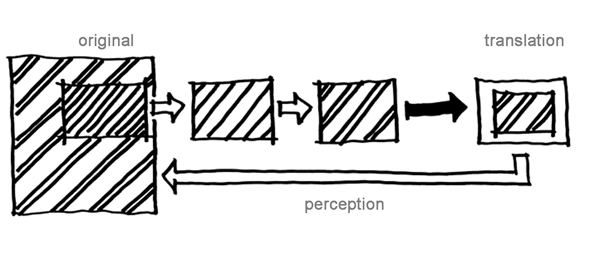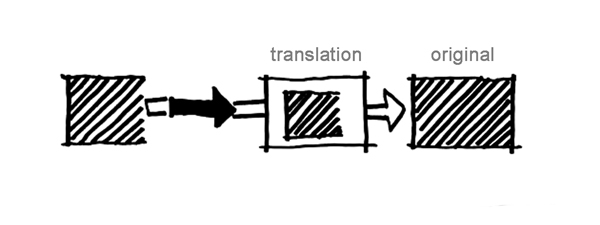| On
the Interpretation of Architecture Applied Interpretation Vol. 13, No. 1, May 2009 |
|||
| ___Christine
Neuhoff Berlin |
The Myth
of Vals – What is it to Design Architecture that is Liked by the Photographic Camera? |
|
Prologue or The Myth of Vals
Myth ... can be read in the anonymous utterances of the press, advertising,
mass consumer goods; it is something socially determined, a ‘reflection’.
This reflection ... is inverted: myth consists in overturning culture
into nature or, at least, the social, the cultural, the ideological, the
historical into the ‘natural’. In most architectural reviews, Peter Zumthor’s thermal bath in Vals gets discussed within the phenomenological context of material and place. Or as Mark Wigley would put it, ‘an entire infrastructure of storytelling labours away to position the building in time ... and place’.[3] Reverence is primarily paid to the bath’s truthful treatment of materials and its refined contextuality. The following quotes might serve as examples for the rhetoric deployed and the bath’s setting within the architectural discourse.
Peter Zumthor – ... devoted to the truth of materials – has as usual
worked in intense contact with the project and its site. ...Through the
rigour of his craft, [he] has realised an extraordinary building
full of sensory richness.[4] Whereas Kenneth Frampton in the last quote characterises the former group of architects by their ‘moralist’, truthful treatment of materials and their preoccupation with the ‘corporal experience, in which the tactile or sensual attributes’[6] are of major importance, he condemns the latter group for their ‘dandified’ manipulation of materials and their striving for purely visual effects.[7] Frampton thus deliberately creates a dichotomy between essence and effect. Zumthor’s work is the paradigm of the first group – essence, substance and truthfulness seem to be the main objectives in his design. Zumthor’s own project descriptions deploy a similar terminology: The establishing of a special relationship with the mountain landscape, its natural power, geological substance and impressive topography ... seemed to us [to play] a more important role: ... In keeping with this idea, it pleased us to think that the new building should communicate the feeling of being older than its existing neighbour, of always having been in this landscape ... [The thermal bath] relies ... on the silent, primary experiences of bathing, cleansing oneself, relaxing in the water; on the body’s contact with water at different temperatures and in different kinds of spaces; on touching stone.[8]
The prevailing visual account of the thermal bath consists in black-and-white
photographs which form part of this ‘infrastructure of storytelling’.
In Peter Zumthor’s own publications, the photographs of the building are
set within a sequence of photographs which visualises the ‘chain of words’
cited above.
By analysing the prevailing rhetoric with regard to Zumthor’s bath, the
objective is to decipher those operations which have given rise to this
rhetoric, rather than to prove it wrong or to suggest a different rhetoric.
The thermal bath serves as a case study for the unveiling
of those operations of myth-building, which are common within architectural
discourses. The analysis of photography’s impact on architecture and photography’s
role within the context of myth-building will be focused on in the following. ***************
Based on these observations, I want to address the different issues arising
with regard to the location and operation of photogenia and other
effects of photographic representation within the context of architecture
along three major themes:
In the
following I want to delineate the setting of my argument and the focus
I chose to approach this investigation. around 1900 technical reproduction had reached a standard that not only permitted it to reproduce all transmitted works of art and thus to cause the most profound change in their impact upon the public; it also had captured a place of its own among the artistic processes,[11] Siegfried Kracauer in Photography claims that ...precisely by exploding perceptual traditions, modern photography ... assumed another function – that of influencing art, ... [and that] ... of all media, realistic photography ... thus ... contributed to the rise of abstract art,[12] and Susan Sontag in On Photography argues that as most works of art (including photography) are now known from photographic copies, photography ... has decisively transformed the traditional fine arts and the traditional norms of taste, including the very idea of the work of art. ...photographs have become so much the leading visual experience that [there are] now works of art which are produced in order to be photographed.[13]
Benjamin, Kracauer and Sontag thus observe the indirect
influences of photography on the perception and conception of arts like
painting or conceptual arts. no longer exclusively located on the construction site, but more and more displaced into the rather immaterial sites of architectural publication, exhibitions, journals.[14] I
want to push this idea further by arguing that it is not just the site
which has been transformed but that the process and objective of architectural
design itself has been altered: the anticipation of photographs, the anticipation
of architecture’s image effects, are productive in the design of
architecture. To think about modern architecture must be to pass back and forth between the question of space and the question of representation. Indeed, it will be necessary to think of architecture as a system of representation, or rather a series of overlapping systems of representation. This does not mean abandoning the traditional architectural object, the building. In the end, it means looking at it much more closely than before, but also in a different way. The building should be understood in the same terms as drawings, photographs, writing, films and advertisements; not because these are the media in which more often we encounter it, but because the building is a mechanism of representation in its own right. The building is, after all, a “construction”, in all senses of the word.[17] In
the course of this thesis, I will argue that certain assumedly natural
categories of the thermal bath, like place and materiality,
might be interpreted as effects of photographic representation. Thus,
my thesis addresses the twin aspects of mythology and photography: in
particular, I want to unveil certain visual effects of the bath which
seem to give reason to the aforementioned rhetoric. On a more general
level, this investigation will demystify the nature and naturalness
of photography and argue that photography is the main means – as distinct
from any other mode of representation – of creating this kind of myth
– understood here in Barthes’ terms as ‘overturning ... the social, the
cultural, the ideological, the historical into the natural’.[18]
In the course of my argument I want to outline the differences between
photography and other modes of representation – like drawing or painting
– to disclose photography’s distinct and unique impact on the perception
and conception of architecture through its formal and structural characteristics. Chapter 1: Photography and Reproduction
Garbo offered to one’s gaze a sort of Platonic Idea of the human creature,
..., an archetype of the human face. ...The face of Garbo is an Idea,
that of Hepburn, an Event. This chapter will address the intrinsic characteristics of photographs and their visual effects. Since photography and its relation to architecture has been written on extensively, I will concentrate on some key texts by Roland Barthes and Walter Benjamin,[36] and develop my argument along the following two issues: the issue of the photographic message and the issue of photography’s reproducibility.
|
||
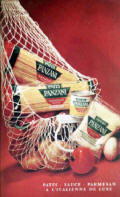 Illustration 1: Panzani advertisement, digital image, source unknown |
Taking
the example of a Panzani advertisement, Barthes identifies a selection
of different signs which might be read in the represented scene:[41]
notably, he claims that the assemblage of pasta, tomato and pepper and the
tricoloured hues of white, green and red of the poster signify Italy or
rather Italianicity. Barthes defines this term as follows:
Italianicity is not Italy, it is the condensed essence of everything that could be Italian, from spaghetti to painting.[42] The term
refers to an abstract idea of Italy rather than to Italy itself.[43]
In the following, I want to elaborate in more detail on the different
aforementioned absences which add up to the photographic effect
of place-y-ness, and explore their individual effects. They might
be assembled into two groups: absence of place and absence of time. ...mountain,
stone, water, building in stone, building with stone, building into the
mountain, building out of the mountain, being inside the mountain: our
attempts to give this chain of words an architectural interpretation,
to translate into architecture its meanings and sensuousness, guided our
design for the building and step by step gave its form.[46] The reconstruction of the Barcelona Pavilion serves as a striking example
of the contentious discussion about what makes a building either independent
from place or contextual. Whereas in the case of the Barcelona Pavilion
the building’s autonomous objecthood is referred to as a proof of its
placelessness,[48]
in the case of the thermal bath, the focal point is slightly shifted:
I want to argue that the thermal bath’s placelessness is not based on
its autonomous objecthood – the bath is not independently ‘sliding through
space’ – but that it is rather based on its endless interior. This interiority
detaches the bath from its particular surrounding place.[49]
Photography tends to suggest endlessness. This follows from its emphasis
on fortuitous complexes which represent fragments rather than wholes.[50] |
|
 Illustration 2: photograph by Volker Schlechtriemen |
It is a crucial operation in architectural photography to deliberately
show just fragments of the building which simultaneously refer to or rather
contain the whole.[52]
The bath’s photographs of the interior space let oneself fantasise about
the building’s endlessness and its consistency beyond the photographic frame.
The power of this photographic effect becomes evident when one
is being confronted with the outside views of the bath: these
photographs seem to render a different building. These views are not contained in the deliberately published canon of interior views.[53] The bath’s placelessness is thus not just due to the absence of place and the absence of certain signs which would place the bath, but it is also due to the bath’s apparently endless interior and the power of its canonical interior views.[54] Photography’s part in establishing myths of contextuality might be examined in the following examples: In the case of the Barcelona Pavilion, advocates of the pavilion’s contextuality ironically looked at black-and-white photographs as a major means of establishing this connection between the pavilion and its physical context. George Dodds notes that the similarity between the three-dimensional vegetation and the two-dimensional veining of the Alpine marble wall is largely a function of the homogenising effect of black-and-white photographic image: reproductions ... demonstrate that the larger and grainier the enlargement, the closer in tonal value the wall and vegetation appear. ... Tegethoff [one of the advocates of the pavilion’s contextuality] projects his own desire to see a connection between the pavilion and its physical context, attributing the visual characteristics of black-and-white photography and photographic enlargement onto the physical character of the building.[55] In similarly ironic way, in the thermal bath, photographs are employed
to create this supposed connection between building and place; not just
single photographs but the persuasive sequence of photographs in Zumthor’s
own publications and his unmistakable chain of words quoted above
establish a story that links the valley, the village, the raw stones and
the finished stonewall of the bath. This sequence of photographs veils
the bath’s potential placelessness as discussed earlier. Roland Barthes
defines this effect of sequence as another kind of signification, which
he calls syntax or concatenation.[56] ...when we, as architects, are concerned with space, we are concerned with but a tiny part of the infinity that surrounds the earth, and yet each and every building marks a unique place in this infinity.[57] To my mind, this understanding has to be supplemented by another observation:
the building’s contextuality is also defined by the building’s deliberate
placement – through distinct choices and modes of representation
– within a certain discursive context. As I have alluded to in the introduction,
the site of architectural production has been shifted from the construction
site to the rather immaterial sites of architectural publication, exhibitions
and journals.[58]
Thus, the thermal bath is not just placed in a particular place in a Swiss
valley, but it is also placed in manifold architectural journals, which
constitute a different contextuality. |
|
|
Illustrations 3-6: Photographs by Christine Neuhoff, collages of inside views of the thermal bath by Christine Neuhoff  Illustration 3: Atlantic coast (1) 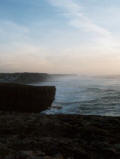 Illustration 4: Atlantic coast(2) 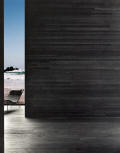 Illustration 5: Collage of interior view (1) 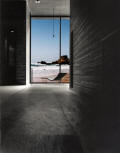 Illustration 6: Collage of interior view (2)
|
Linked to this metaphorical meaning of the frame
is the twofold characteristic of the literal frame and its interrelation
with the place it frames: The literal frame in the thermal bath both unites
the bath with its surrounding landscape – this framed landscape becomes
part of the bath’s interior –, and at the same time pictorialises this landscape
and de-contextualises it from that particular site. What might be seen as
the proof of the bath’s contextuality – the visual merging of the
interior bathing space and the mountain landscape – might conversely prove
the argument that the thermal bath would connect to any place it frames.[59]
So both a different sequence of photographs and a collage of some interior
views might visualise the potential dislocation of the thermal bath, for
example to the Atlantic coast. Thus, the myth of the bath’s refined contextuality
has been demystified as a construct of photographs and deliberate
framings. As a final point with regard to the bath’s effect of place-y-ness, I want to draw attention to the way in which the black-and-white photographs of the bath recall certain stage designs of Adolphe Appia, a Swiss artist of the late 19th, early 20th century.[60] It is noteworthy that there is not just a formal resemblance between the bathing space and these stage settings,[61] but there is also the particular implication of the spatial category of the stage: the stage is a unique category of space which might represent all other places but itself. It is a generic place – an idea of place – which becomes a specific place through action. Accordingly, the thermal bath might be interpreted as a rather generic category of place, or as I have called it before, an idea of place, which becomes a bathing place or a fashion place as a result of the action performed in it. Further, it can only become a fashion place because it is not, in the first instance, exclusively conditioned as a bathing place. Thus, the bath might be interpreted as a stage, a neutral, unconditioned place, rather than a specific place. absence of time – timelessness The place effect described above gets supplemented by a time effect which is produced by the absence of different signs in the black-and-white photographs, the absence of colour, and the absence of people and clothes. The absence of colour imbues the photographs with a time effect, an effect which detaches the object photographed from the distinct time even more than a colour photograph.[62] Black-and-white photographs already in the present, in the moment when the picture is taken, cut off the object’s relation to time, position the depicted object outside of time’s flow. Moreover, black-and-white photographs are often felt to be more aesthetisizing and purifying than colour photographs. The black-and-white photographs of the thermal bath do not show people in the act of bathing, but they exclude every sign of action. Is this due to the conviction that ‘the intrusion of bodies ... violates the balance of a precisely ordered geometry’, as Bernard Tschumi suggests in his Questions of space?[63] Referring to Barthes’ quote on Greta Garbo and her face effect elucidates the idea that the black-and-white photographs of the bath deliberately capture an idea of space, an ‘archetype’ of space, rather than a specific event in a specific time. Garbo offered to one’s gaze a sort of Platonic Idea of the human creature, ..., an archetype of the human face. ... The face of Garbo is an Idea.[64] Furthermore, there are no signs of weather or clothes which could have an impact on placing the bath in a particular time or age.[65]
The fashion photographs of the thermal bath refer to the black-and-white
photographs’ site-less and time-less idea of place rather than
to the distinct place of the bath. Thus, one might argue that specific
architectures like the thermal bath or the Barcelona Pavilion are settings
for advertisements since they already signify a culturally shared, abstract
idea of place. This idea of place acts like a sleek continuous background
for the object advertised, whereas every other place which had not that
quality of place-y-ness would obstruct the frank and emphatic message
of the advertisement. new minimalism isn’t just an architecture that looks good in glossy magazines [but that] the style is a glossy magazine.[66] The neutral quality of minimalist interiors does not distract the viewer
from the fashions exhibited, but reinforces the act of looking as the
privileged activity; moreover, these interiors become fashionable images
themselves. While refraining from any discussion of whether the bath is
minimalist in style or not,
this digression nevertheless gives an insight into the bath’s
operation as a background for advertisements and its image effect.[67] |
|
 Illustration 7: View from outside (1), photograph by Christine Neuhoff  Illustration 8: View from outside (2), photograph by Christine Neuhoff |
Thus, one might conclude, that instead of the bath’s careful placing, it
is rather the bath’s place-y-ness, its place effect, created by the
power of photographic signification, which is paid reverence to. The inconsistency
of place-y-ness and place, and the impact of the black-and-white
photographs on the bath’s perception become obvious when these images are
compared to coloured and peopled photographs,[69]
or when actually visiting the bath: the ordinariness of the bath’s performance
as a swimming pool for ordinary people, coloured towels and flip-flops,
people and their unbecoming swim wear undermine the image effect
of the black-and-white photographs, which again proves that place-y-ness
is an effect of photography rather than found in the place itself.[70] This part on the photographic message has analysed photography’s power to establish certain myths by overturning the cultural into the natural, through photography’s twofold characteristics of connotation and denotation. II Whereas in the first half of this chapter I concentrated on the photographic message, I now want to focus rather on the technical side of the photograph, on the photograph’s quality of reproducibility as it is pointed out by Walter Benjamin in his text The Work of Art in the Age of Mechanical Reproduction.[71] Walter Benjamin identifies the distinct differences between a work of art and its reproduction, and the effects of photography on the perception and conception of a work of art. This analysis of photography’s innate characteristics might give some insight into the photograph’s impact on the perception of the thermal bath. The first distinction between a work of art and its reproduction is that of presence in time and space – authenticity – which is the main characteristic of the original, whereas its lacking is the main characteristic of the reproduction.
When
applying these two categories of authenticity and aura to the interrelation
of architecture and its photographic reproduction, one might contend Benjamin’s
claim: do not distinct images – for example reproductions of the Parthenon
in Athens – capture an aura of the building which seems to be lost when
one actually visits it? Is it just the frame of the photograph
which is missing when moving through the space, the frame, which kept
all distractions out of sight, which in a way purified the object from
its distinct place. Might one distinguish between two different kinds
of auras, the one of the building which is characterised by its
presence to all senses, by inclusion and complex stratification – the
one Benjamin is talking about – and the one of the photograph which works
purely visual, by exclusion and purification? Thus could one define place-y-ness
as the aura of the photographs as opposed to the aura of the place itself?
This interpretation recalls the argument of the first part,
namely that the effect of place-y-ness is an effect of the
photographic message, affected by the different absences – absence of
place and absence of time. ...technical reproduction can put the copy of the original into situations which would be out of reach for the original itself. Above, it enables the original to meet the beholder halfway. ...and in permitting the reproduction [to do this], it reactivates the object reproduced.[74] Moreover, with works of art being designed for reproducibility, the notion of authenticity ceases to be of importance, since by definition there can be no authentic print.[75] As a result of this change, ‘the total function of art is reversed’; this brings me to the next characteristic of photography which will be crucial in the course of my argument: In photography, exhibition value begins to displace cult value all along the line.[76] Benjamin
observes that works of art are received and valued on two different planes:
on one plane, the emphasis is on the cult value of a work of art, on the
other, the emphasis is on the exhibition value. While for the former,
the existence of the work of art itself matters, for the latter just being
on view is the objective. The striving for exhibition value induces
a qualitative transformation of the nature of the work of art.
The analysis of the bath’s photographs with regard to Barthes’ theory of the photographic message elucidated photography’s power and influence on the perception of the depicted object, and unveiled the myth of the bath’s contextuality in parts as an effect of photography. Benjamin’s analysis of the intrinsic characteristics of photography has opened up several questions with regard to the interrelation of architecture and photography, one of which is: what is it to design architecture which is appreciated for its exhibition value, which is reproducible in images? Since not every place produces the effect of place-y-ness in a photograph, in the following I will first analyse the distinct operation of translating architecture into photographs, and then search for the source of that effect in architecture itself.
Now, once I feel myself observed by the lens, everything changes: I constitute
myself in the process of ‘posing’, I instantaneously make another body
for myself, I transform myself in advance into an image. In the second chapter, I want to look at the characteristics of translation, focusing on the act of translating rather than the final product, the translation itself. How does this distinct operation influence the status of both the original and the translation? In the first part of this chapter, I will convey my take on Walter Benjamin’s definition of translatability within linguistics and transpose some of his ideas onto architecture and photography.[83] Moreover, I will look at Robin Evans’ notions on translations.[84] My argument will be developed with regards to the process of translation, and the issue of the translation’s impact on the perception and conception of the original. In the last part of this chapter, I will give a short account of Mies van der Rohe’s and Peter Zumthor’s design processes with regard to the discussed issues.
To comprehend [translation] as mode one must go back to the original, for that contains the law governing the translation: its translatability.[87] When approaching the translatability of a work of art, Benjamin distinguishes
between two questions: the first one asks whether an adequate translator
could ever be found among the totality of its readers, whereas the second
asks – to his mind the crucial question – whether the original’s nature
lends itself to translation or rather, ‘in view of the significance of
the mode, calls for it’.[88]
Could this quality of translatability be compared to the quality of
photogenia? Do faces or buildings call to be translated into a photograph?
I will come back to this issue later on but first I want to concentrate
on the process of translation, as it is defined by Benjamin with regard
to linguistics. important works of world literature never find their chosen translators at the time of their origin.[89] Benjamin
defines the eternal afterlife of the original as fame. According
to his definition, only when the original achieves fame, is the translation
enabled. in its afterlife, which could not be called that, if it were not a transformation and a renewal of something living, the original undergoes a change.[90] Hence,
Benjamin questions the static quality of the original when he refers to
historical processes as having an impact on the original. |
|
 llustration 13: Parthenon (1), source unknown 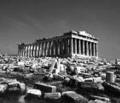 llustration 14: Parthenon (2), photograph by Christine Neuhoff 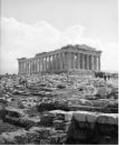 llustration 15: Parthenon (3), source unknown |
Another
issue I want to discuss is the translation’s influence on the positioning
of the original in a distinct context. This might be read
in connection with the aforementioned notion of ‘storytelling’ and
Susan Sontag’s observation that each family constructs its own portrait
chronicle, its own history through a selection of photographs. Each ‘story’
on or of a building, the rhetoric deployed, its deliberate presentation
in exhibitions, the photographs taken of it etc. might be interpreted as
yet another translation, as yet another positioning within a distinct context.[92]
When focussing just
on the medium of photography, one might argue that the first photographs
published of a building define the building’s visual admission into the
cultural context and thus profoundly influence the perception of it. It
seems as if the first prominent gaze imprints itself on the original
and even determines future visual recordings. It is noteworthy how people
take photographs of visually well known buildings: they try to capture the
same iconic image they have already seen several times, the image, which
enforces itself in every repetition.[93] After having analysed the characteristics of the process of translation, I want to elaborate on the translator’s task as described by Benjamin, and analyse in more detail the operation’s impact on the status of the original and the translation. Benjamin claims that: The task of the translator consists in finding [the] intended effect (Intention) upon the language into which he is translating which produces in it the echo of the original.[94] When transposing this idea onto architecture and its photographic translation,
one would conventionally argue that the photographer has to search for
the intended effect and translate this intention, so that the photograph
produces an echo of the original. Referring back to Benjamin’s notion
of translatability one could ask in how far the translatability of the
original has an influence on the translator’s work. One might question
whether some architectures, in anticipation of the photographic translation,
present the intended effect more frankly to the camera eye than others,
whether some architectures lend themselves to the production of the original’s
echo in the photographic translation.[95] The basic error of the translator is that he preserves the state in which his own language happens to be instead of allowing his language to be powerfully affected by the foreign tongue. Particularly when translating from a language very remote from his own he must go back to the primal elements of [the] language itself and penetrate to the point where work, image, and tone converge. He must expand and deepen his language by means of the foreign language. ... The extent to which a translation manages to be in keeping with the nature of this mode is determined objectively by the translatability of the original.[96] Within the context of architecture and photography, this operation of
influence described in the first part of the quote is the conventional
one: a photographer is congratulated when her photographs produce an echo
of the original which she supposedly achieves when being influenced by
the specific language of the building.[97]
The last part of the quote already implies that the photograph’s successful
translation is bound to the architecture’s translatability.
Now, once I feel myself observed by the lens, everything changes: I constitute
myself in the process of ‘posing’, I instantaneously make another body
for myself, I transform myself in advance into an image.[98] Hence, an object photographed intends a certain reading with a certain pose. This act of posing is another characteristic which distinguishes photography as a means of representation from other representational modes like drawing or painting. While one might pose for a painting as well as for a photograph, the analogical nature of the photograph distinguishes the effect of posing: it naturalises the act of posing into an actual fact.[100] Roland Barthes observes the complexity of this act of posing in portrait photography: The portrait photograph is a closed field of forces. Four image-repertoires intersect here, oppose and distort each other. In front of the lens, I am at the same time: the one I think I am, the one I want others to think I am, the one the photographer thinks I am, and the one he makes use of to exhibit his art. In other words, a strange action: I do not stop imitating myself...[101] Within the practice of architecture, this act of posing becomes even more
complex: with the architect, another party joins in. The architect decides
about how his building poses in front of the photographic camera.
Moreover, he himself poses through the building and thus intends a specific
reading of the building, of himself and his values. Although one might
think that the building cannot adopt more than a single pose – due to
its characteristic of being static – in this single pose, the architect
has – potentially – taken into account the different parameters which
influence the building’s act of posing: light and weather conditions and
the different perspectives of the moving eye and moving camera eye. Thus,
with regard to a building’s pose, the parameters of mobility and stasis
are somewhat reversed: it is not the object photographed which moves into
a pose, or changes from one pose into another, but it is the camera eye
that captures different poses of a building by moving through it.[102] Drawing in architecture is not done after nature, but prior to construction; it is not so much produced by reflection on the reality outside the drawing, as productive of a reality that will end up outside the drawing. The logic of classical realism is stood on its head, and it is through this inversion that architectural drawing has obtained an enormous and largely unacknowledged generative power: by stealth.[105] Evans’ notion of the drawing’s productiveness still acknowledges the temporal
sequentiality of drawing and building. In contrast, I want to argue that
– by transposing this idea on architecture and photography – photographs
are not so much the reflection of a reality, but similarly productive
of a reality like drawings, even when being in the temporal chain later
than the original. This idea refers back to the interpretation of the
architect’s task as that of translating photographs into architecture.
What might seem like a paradox just calls for the imaginative mind and
the knowledge of the formal connection between the original and its photographic
translation, which will be the focus of the next chapter. In Palladio’s sketch of the S. Petronio facade the close alignment (but not quite identity) between drawing and building is at once obvious. This is the kind of architecture that so much fascinated Alberti: a massive, monumental architecture engendered from the etiolated, reduced, bodiless elements of ‘lines and angles which comprise and form the face of the building’; an architecture made through drawing and made of the same species of illusion as is to be found in drawing.[106] One might argue that a comparable alignment also exists between certain
architectures and photography, and that this alignment defines architecture’s
photogenia. Perusing the slides I had taken of the reconstructed pavilion, I found it difficult to decide which way up they went – an artefact of photography, no doubt. Then I changed my mind. It was not an artefact of photography, but a property of the pavilion itself, a property of which I had not been conscious while there. The photographs had made it easier to discern.[110] Evans claims that ‘the horizontal symmetry of the Barcelona Pavilion is very powerful’[111] although he had not been conscious of it while being there.[112] In an ironic way, he looked at photographs of the pavilion to observe the horizontal symmetry as a reality of the pavilion. I have since looked at as many photographs as I could find of both the original and the reconstructed pavilion. ... They show that ... in Mies’s pavilion the plane of symmetry is almost impossible to escape.[113] Rather than interpreting this horizontal symmetry as a property of the
pavilion, I would approach this observation by distinguishing between
property and effect. I will argue that the effect
of horizontal symmetry just exists in the photographs and is specifically
intended for the pavilion’s apprehension through the photographs; it has
got nothing to do with the unmediated perception of the pavilion’s reality.[114]
Instead of the effect, it is the source of this effect – the architectural
disposition – which has to be a property of the pavilion itself. Mies’ working methods ... effectively merged a project’s guiding concepts with highly visual forms of their own promotion.[115] By referring to the Seagram building, Steele points out that the company’s
advertising and publicity interests were not only central to but moreover
lead to Mies’ commission. Mies’ obsession with simulating the effects
of his spaces might be seen in his numerous photographic collages, which
anticipate the visual effects of the space on a two-dimensional plane
and which envision future photographs. Mies is the most important modern architect to a new generation because he’s the easiest to copy – well.[116] Whereas Mies’s bravura within this context is widely recognised, the anticipatory impact of photographs on the design process also applies to Zumthor, when he himself says: All too often in the design process you reach a point when the initial warm feeling for the object or the space begins to suffocate under the intellectual and theoretical justification for designing a specific element in a specific way. ... When this happens, my method is to say to people: ‘Step back from what your have lying there on the table. Imagine for a moment that the thing on the drawing has been built and that you’re seeing it in a movie. You’re not responsible for anything. You can cut your ties, regain some sort of innocence, and just let this ‘thing’ have an impact on you.[117] Seeing
it in a movie is the crucial phrase in that statement: Zumthor does not refer to the experience
of space but to the operation of framing space. He thus in the design
process employs the means of the frame, or rather a sequence of many frames,
to scrutinise the design in terms of its future image effects. Linked
to this design technique is the method of taking endoscopic photographs
of card models which render the image effect of the space.
Having started off from Benjamin’s notion of translatability, I have analysed
the interrelations of original and translation and their possible reciprocal
impact. I have argued that within the context of architecture and photography
the process of translation might not only follow a one-way linear pattern,
but that future translations – future photographs – might have a major
impact not just on the perception but also on the conception of the original.
This observation redefines the task of the architect as the task of a
translator: he translates future photographs into architecture. Chapter 3: Vision and Form Nobody ever discovered ugliness through photographs. But many,
through photographs, have discovered beauty. This chapter addresses the object itself in search of the source of its visual effects in photographs, its photogenia. Since not every place produces the effect of place-y-ness in a photograph, I want to ask: what is it in architecture that defines Benjamin’s translatability or Evans’ alignment with photography? This part will be mainly based on Heinrich Wölfflin’s Principles of Art History.[121] Whereas in the first half the correlation of vision and form will be discussed, in the second half, the focus will be the effect of the picturesque within architecture.
Every artist finds certain visual possibilities before him, to which he is bound. Not everything is possible at all times. Vision itself has its history, and the revelation of these visual strata must be regarded as the primary task of art history.[124] Hence,
there is a history of vision which has an impact on the creation of art.
The analysis of architectural forms and their appreciation by the human
eye and the camera eye respectively will be the focus of this chapter,
rather than a comparative evaluation of the aesthetic quality of the different
representational forms.[125] every epoch perceives with its own eyes, [and that] the historian must ask in each case how a thing demands to be seen in itself,[126] I want to ask, how does architecture, which will be mainly perceived through
photographs, demand to be seen and therefore demand to be designed?[127] to me, buildings can have a beautiful silence that I associate with attributes such as composure, self-evidence, durability, presence and integrity, and with warmth and sensuousness ...; a building that is being itself, being a building, not representing anything, just being.[130] |
|
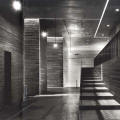 Illustration 17: photograph by Christine Neuhoff 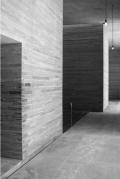 Illustration 18: photograph by Christine Neuhoff 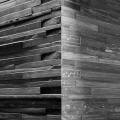 Illustration 19: photograph by Christine Neuhoff 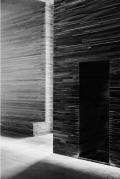 Illustration 20: photograph by Christine Neuhoff |
In
the following, I want to analyse the visual effects of the thermal bath
with regard to Wölfflin’s catalogue of formal issues. The illustrating photographs
have to be looked at with regard to the architecture they transmit, not
with regard to the artistry of photographic composition. This already
implies that my following formal analysis is based on the photograph’s analogical
nature:[131]
the knowledge of photography’s analogical nature is a necessary presupposition
for the argument that there exists a certain alignment between architectural
form and photographic vision. Wölfflin states that in linear vision, the sense and beauty of things is first sought in the outline, ..., [and] that the eye is led along the boundaries and induced to feel along the edges.[132] He claims that classic forms work throughout with clear-cut, tangible boundaries; every surface has a definite edge, every solid has a perfectly perceptible form. Thus, linear vision sharply distinguishes form from form, as the crisp lines separate the different forms and volumes from each other. Linked to that notion of tangible boundaries is the observation that in linear vision and architecture, light and shadow serve the form and emphasise the impression of plasticity.[133] As a result of the combination of the aforementioned notions of form, light and shadow, Wölfflin proclaims that the linear style produces a tactile picture: The evenly firm and clear boundaries of solid objects give the spectator a feeling ... as if he could move along them with his fingers, and all the modelling shadows follow the form so completely that the sense of touch is actually challenged. Representation and thing are, so to speak, identical.[134]
Wölfflin argues that the operation which the eye performs resembles the
operation of the hand which feels along the body. possesses a perfectly well-developed feeling for volume, but it forms volume in a different spirit from the baroque. It seeks stratification in planes, and all depth is here a consequence of such plane sequences, while the baroque from the outset avoids the impression of the planimetric and seeks the real essence of the effect, ... , in the intensity of the perspectives in depth.[135]
Linked to that notion of stratification, Wölfflin argues that classic
architecture does not demand the oblique view but that ‘the pure frontal
aspect will always make itself felt as the one lying in the nature of
the thing’.[136]
Whereas his claim seems to be valid in the interior of the thermal bath
or the Barcelona Pavilion – the volume is felt as a stratification of
different volumes, planes and spaces rather than as being perspectival
– it seems not to hold for the views from the outside. To my mind, Wölfflin
in his endeavour to set up absolute categories, underestimates the great
effect an oblique view might have even in classical architecture; one
just has to think of the magnificent photographs taken of the Parthenon
from the propylaeum or the Barcelona Pavilion taken from an oblique point
of view; do not the perfect rhythm of the columns of the Parthenon and
the autonomous objecthood of both the Parthenon and the Barcelona Pavilion
have even greater effect when seen from an oblique point of view? Perhaps
Wölfflin should have distinguished between views from the outside and
views in the inside.[137] either no standpoint of the spectator – certain distortions of the form always being present – or all. ...[Whether seen] foreshortened or not, with or without intersection of the forms, ..., yet from all standpoints, the tectonic basic form will penetrate as the decisive element.[138] |
|
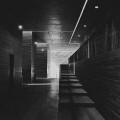 Illustration 21: Viewpoints (1), photograph by Christine Neuhoff 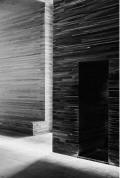 Illustration 22: Viewpoints (2), photograph by Christine Neuhoff 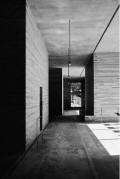 Illustration 23: Viewpoints (3), photograph by Christine Neuhoff 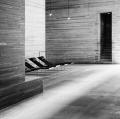 Illustration 24: Viewpoints (4), photograph by Christine Neuhoff 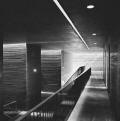 Illustration 25: Viewpoints (5), photograph by Christine Neuhoff |
Given the analogical nature of photographs and that there supposedly can
be no ‘wrong’ views of the linear architecture itself, one could argue that
similarly ‘wrong’ photographs of the thermal bath cannot exist. Thus, one
might define photogenia as an effect of linear architecture, since
it is somehow impossible to misinterpret the architecture’s effect in photographs
and since it is rather easy to take ‘right’ photographs.[139] Wölfflin expands his argument of correlating vision and form with regard to the role of representation. He argues that certain architectures provoke not just a specific form of visual apprehension but also call for a specific form of representation. He explores that idea in considering the baroque facade of S. Andrea della Valle in Rome, which could be caught in a sketch with mere dabs of the brush, as opposed to all classic architectures, which require the most definite rendering of proportion and line.[140] I want to extend Wölfflin’s argument in proposing that certain architectures call for photography as their means of representation which is even more accurate with regard to the exact rendering of proportions, form and line than a drawing could ever be. II Linked to the notion of spatial stratification, plane sequences and the discussion on multiple viewpoints is the effect of visual apprehension of architecture from within movement and the idea of the picturesque. Or to put it in Yve-Alain Bois’ words, who observed a reversed causality, ...the multiplicity of views is the question opened by the picturesque.[141] Hence,
the bath’s image effect, the bath’s photogenic quality might
also be based on its picturesque quality – defined here by the
possibility of multiple viewpoints and the disposition of space as a sequence
of picturesque stills. In the thermal bath, the sequential clicking
of the eye, the clicking of the camera shutter, seems to best capture
the bath’s spatial and visual quality. Thus, not the continuous movement
is the vehicle of apprehension and evaluation – that for example Richard
Serra’s sculptures would call for – but sequential standstills. ...even in a purely linear presentment – and this is the decisive point – a certain decorative picturesque effect ... remain[s].[144] Auguste
Choisy’s analysis of the Acropolis in Athens
might be read with regard to Wölfflin’s
discussion of the picturesque.[145]
In his chapter The
picturesque in Greek Architecture,
Choisy interprets the architecture of the Acropolis as a sequence of
tableaux which offer themselves to the visitor’s gaze in the 5th century
BC.[146]
This digression into different theories on sequential readings of picturesques and on montage within film shows once again that some effects even if provoked by a certain architectural setting, crucially exist in only the perception of it. The allusion to S.M. Eisenstein perhaps best exemplifies the anticipatory calculation of pictorial effects when transposing a 3-dimensional space or reality onto a 2-dimensional plane, the movie screen.
Heinrich Wölfflin’s comparative analysis of classic and baroque vision
and form has been very influential and effective within architectural
history and theory, but one should not underestimate the impact of the
two screens and the use of this clear cut dichotomy on the persuasiveness
of his theory. Wölfflin was the first one to introduce two lanterns and
two screens in the lecture halls in order to sharpen the eye to the stylistic
differences between two comparable works of art. By the means of photography
and this comparative two slide projection, the attention is focussed on
certain aspects of the buildings, and the photographs in comparison depict
what might have been overlooked otherwise. Thus again, the naturalness
of the photographs veils intention and possible manipulation: connotation
procedures like choice, frame, exposure, angle, etc. are deliberately
employed in order to achieve the intended effect. As Gombrich points out,
Wölfflin made the polarities of the baroque and classical look like strong
polarities through his choice of examples and his powers of description.
This method of basing an argument on two polarities became fashionable
in the 18th century, another example of which is Burke’s Sublime and
Beautiful.[152]
Gombrich criticises these polarising conceptual systems for always making
exclusive claims and making previous classification obsolete.[153] it is certainly right that art has always been able to do what it wanted and that it dreaded no theme because ‘it could not do it’, but that only that was omitted which was not felt to be pictorially interesting.[154] he
never turns the argument around and claims, that one might do something
just because it is first of all pictorially interesting, that one might
do something just because of the image it produces. In the first part of this thesis, I focussed on the medium of photography
by pursuing two strands of thought: the unveiling of photographic messages,
in particular the signification of place-y-ness, and the analysis
of photography’s characteristic of reproducibility. In the
second part, I focussed on the intrinsic characteristics of the operation
of translation within the context of architecture and photography was,
while I refrained from discussing the dichotomy of original and translation,
and from embarking on any moralistic discussion about the difference between
the real and the image or between the ‘truthful’ and the ‘lie’. In the last part, I looked at architecture itself in order to trace its
photogenia, its translatability, and to find an explanation for
the observed alignment between certain architectures and photography.
By linking the notions of signification and effect with
Wölfflin’s theory on the correlation of vision and form, one could establish
a new definition of photogenia and photography’s impact on the
conception of architecture. With reference to my short definitions of
photogenia and place-y-ness, one could argue: while photogenia
is not found in the face itself, it is noteworthy that it is produced
just by some faces! while place-y-ness is not found in the place
itself, it is noteworthy that it is produced just by some places! Illustration credits: Figure
1:
Panzani advertisement, digital image, source unknown. Bibliography: Bablet, Marie-Louise. ‘Adolphe Appia – ‘Inventor’ of Modern Theatre or: Space-Creating Light’. Daidalos 14.46-65. 1984. Barthes, Roland. Image Music Text. London: Fontana Press, 1977. Barthes, Roland. Mythologies. London, Vintage, 1993 [first published in 1957] Barthes, Roland. Camera Lucida. London: Vintage, 1993 [first published in 1980] Batchen, Geoffrey. Each Wild Idea. Writing Photography History. Cambridge: The MIT Press. 2001. Baudelaire, Charles. ‘The Modern Public and Photography’. in: Trachtenberg, Alan (ed.). Classic Essays on Photography. New Haven: Leete’s Island Books: 1980. 83-89. Baudrillard, Jean. Simulacra and Simulation. Michigan: The University of Michigan Press, 1994. Bazin, André. ‘The Ontology of the Photographic Image’. in: Trachtenberg, Alan (ed.). Classic Essays on Photography. New Haven: Leete’s Island Books: 1980. 237-244. Beacham, Richard C. Adolphe Appia: Artist and Visionary of the Modern Theatre. Harwood Academic Publishers, 1994. Beacham, Richard C. Adolphe Appia. Theatre Artist. Cambridge: Cambridge University Press, 1987. Benjamin, Walter. ‘The Task of the Translator’. 1923. in: Hannah, Arendt (ed.). Illuminations. Walter Benjamin – Essays and Reflections. New York: Schocken Books, 1978. 69-82. Benjamin, Walter. ‘ A Small History of Photography’. 1931. in: Benjamin, Walter. One Way Street and other writings. London: Verso 1985. 240-257. Benjamin, Walter. ‘The Work of Art in the Age of Mechanical Reproduction’. 1936. in: Hannah, Arendt (ed.). Illuminations. Walter Benjamin – Essays and Reflections. New York: Schocken Books, 1978. 217-251. Berger, John. ‘Understanding a Photograph’. in: Trachtenberg, Alan (ed.). Classic Essays on Photography. New Haven: Leete’s Island Books: 1980. 291-294. Bois, Yve-Alain. ‘A Picturesque Stroll around Clara-Clara’. in: Michelson, A., Krauss, R., Crimp, D. Copjec, J. (eds.). October. The first decade, 1976-1986.Cambridge, London: The MIT Press, 1987. 342-372. Bois, Yve-Alain. ‘Sergei M. Eisenstein. Montage and Architecture. Introduction’. assemblage 10, 12/1989. 111-131. Burke, Edmund. A Philosophical Enquiry into the Origins of our Ideas of the Sublime and Beautiful. Oxford: Oxford University Press, 1990. [first published in 1757] Choisy, Auguste. Histoire de l’architecture. Tome Premier. Paris: Librairie Georges Baranger, 1943. [first published in 1899] Clarke, Graham (ed.). The Portrait in Photography. London: Reaction Books Ltd., 1992. Colomina, Beatriz. ‘The Split Wall: Domestic Voyeurism’. in: Colomina, Beatriz (ed.). Sexuality and Space. New York: Princeton Architectural Press, 1992. 73-128. Colomina, Beatriz. Privacy and Publicity – Modern Architecture as Mass Media. Cambridge, London: The MIT Press, 1994. Damisch, Hubert. ‘Five Notes for a Phenomenology of the Photographic Image’. in: Trachtenberg, Alan (ed.). Classic Essays on Photography. New Haven: Leete’s Island Books: 1980. 287-290. Dodds, George. Building Desire. On the Barcelona Pavilion. London: Routledge, 2005. Quotes are taken from the unpublished manuscript, 2004. Eisenstein, S. M. ‘Piranesi, Or The Fluidity Of Forms’. Oppositions 11, Winter 1977. 83-115. Eisenstein, S. M. Towards a Theory of Montage Volume II. London: British Film Institute, 1991. Evans, Robin. ‘Translations from Drawing to Building’. (1986) in: Evans, Janet (ed.). Translations form Drawing to Building and Other Essays. London: Architectural Association, 1997. 153-194. Evans, Robin. ‘Mies van der Rohe’s Paradoxical Symmetries’ (1990). in: Evans, Janet (ed.). Translations form Drawing to Building and Other Essays. London: Architectural Association, 1997. 233-277. Foucault, Michel. The order of things. London: Routledge, 1989. Gombrich, E. H. Gombrich on the Renaissance. Volume 1: Norm and Form. London: Phaidon Press Limited, 1966. Haus, Andreas. ‘Photogenic Architecture.’ Daidalos 66. 12/1997. 90. Heidegger, Martin. ‘Building Dwelling Thinking’ in: Poetry, Language, Thought. New York: Harper & Row, 1971. 143-159. Kracauer, Siegfried. ‘Photography’. in: Trachtenberg, Alan (ed.). Classic Essays on Photography. New Haven: Leete’s Island Books: 1980. 245-268. Le Corbusier. Le Corbusier. The Complete Architectural Works – 1929-1934. Volume 2. London: Thames and Hudson Limited, 1966. Le Corbusier. Précisions – On the present state of architecture and city planning. Cambridge, London: The MIT Press, 1991. Le Corbusier. Towards a New Architecture. New York: Dover Publications, 1986 [first published in 1931]. Mallgrave, Harry Francis and Ikonomou, Eleftherios (eds.). Empathy, Form, and Space. Problems in German Aesthetics, 1873-1893. Santa Monica: Ghetty Center for the History of Art and the Humanities, 1994. McHale, John. ‘The expendable ikon 1’. in: Architectural Design 29, 82-83, 2/1959 McHale, John. ‘The expendable ikon ’. in: Architectural Design 29, 116-117, 3/1959 Moholy-Nagy, Lazlo. Painting Photography Film. Cambridge, Mass.: The MIT Press, 1967. Morin, Edgar. Le Cinéma ou l’homme imaginaire. Paris: Editions Gonthier, 1958. Rowe, Colin. ‘The Mathematics of the Ideal Villa’. [first published in 1947] in: The Mathematics of the Ideal Villa and Other Essays. Cambridge, London: The MIT Press, 1976. 1-28. Rowe, Colin and Slutzky, Robert. ‘Transparency: Literal and Phenomenal’. [written 1955-56, first published in 1963] in: The Mathematics of the Ideal Villa and Other Essays. Cambridge, London: The MIT Press, 1976. 159-184. Rowe, Colin and Slutzky, Robert. ‘Transparency: Literal and Phenomenal (Part 2). in: Ockman, Joan (ed.). Architecture Culture 1943-1968: a documentary anthology. New York: Rizzoli, 1993. 205-225. Schulze, Franz. Philip Johnson: Life and Work. New York: A.A. Knopf, 1994. Sontag, Susan. On Photography. London: Penguin Books, 2002 [first published in 1977] Steele, Brett. ‘Minimal Returns: Modernism in Drag’, in: Architectural Association. Beyond the Minimal. 1998. 97-99. Steele, Brett. ‘Absolut Mies, Absolute Modern: Building Good Copy’. AA Files 48. Winter 2002. 3-14. Tschumi, Bernard. ‘The Pleasure of architecture’. in: Architectural Design, 214-218, 3/1977. Tschumi, Bernard. Questions of Space. Lectures on Architecture. London: Architectural Association Publications, 1990. Wigley, Mark. ‘The Architectural Cult of Synchronisation’. in: OCTOBER 94, 31-61, Fall 2000. Valéry, Paul. ‘The Centenary of Photography’. in: Trachtenberg, Alan (ed.). Classic Essays on Photography. New Haven: Leete’s Island Books: 1980. 191-198. von Amelunxen, Hubertus. ‘Translating Architecture – Points of Reference’. in: Architecture of Zaha Hadid in photographs by Hélène Binet. Baden: Lars Müller Publishers, 2000. Wölfflin, Heinrich. Renaissance and Baroque. London: The Fontana Library, 1964. [first published in 1888] Wölfflin,
Heinrich. Principles of Art History. New York: Dover Publications,
1950. [first published in 1915]
Bibliography
on Peter Zumthor and his work: a+u Extra Edition. Peter Zumthor. 2/1998. Achleitner, Friedrich. ‘The Return of Modernism’. Architektur Aktuell. 66-79. 4/1997. Achleitner, Friedrich. ‘Questioning the Modern Movement’. in: Peter Zumthor. a+u Extra Edition. 2/1998. 206-212. Adam, Hubertus. ‘Qualität statt Quantität’. archithese vol.31. 66-67. 1/2001. Janser, Andres. ‘Moduliertes Licht’. archithese vol.27. 58-63. 4/1997. Luchsinger, Christoph. ‘Täuschend echt’. werk, bauen + wohnen. 4-11. 7+8/1997. Nakao, Hiroshi. ‘No Ideas but in Things’. in: Peter Zumthor. a+u Extra Edition. 2/1998. 220. Noseda, Irma. ‘Das Fremde und das Eigene – Ein Gespräch’. archithese vol.16. 7-10. 6/1986. Noseda, Irma. ‘Hotel Therme in Vals’. archithese vol.16. 29-32. 6/1986. Ryan, Raymund. ‘Primal Therapy’. Architectural Review. 42-49. 8/1997. Spier, Steven. ‘Place, authorship and the concrete: three conversations with Peter Zumthor’. arq vol.5, no.1, 2001. 15-36. Steinmann, Martin. ‘Understanding through the Senses. Some Remarks on Peter Zumthor’s Work’. a+u 316. 87-88, 1/1997. Trétiack, Philippe. ‘Zumthor en toute sensualité’. D’Architectures 104. 36-47. 2000. Tschanz, Martin. ‘Das spezifische Gewicht der Architektur - ...begeistert vom Körper’. archithese vol. 26. 29-33. 5/1996. Tschanz, Martin. ‘Das Thermalbad in Vals’. archithese vol.26. 34-35. 5/1996. Wessely, Heide and Zumthor, Peter. ‘I built on my experience of the world... – an Interview with Peter Zumthor’. detail, 24-27, 1/2001. Widder, Lynnette and Confurius, Gerrit. ‘Questioning Images. Interview with Peter Zumthor’. Daidalos 68, 90-101, 6/1998. Zumthor, Peter. Partituren und Bilder. Architektonische Arbeiten aus dem Atelier Peter Zumthor 1985-1988. Haldenstein: Peter Zumthor, 1989. Zumthor, Peter. ‘From passion for things to the things themselves’. in: Tuukkanen, Pirkko (Hg.). Architecture of the essential. The 6th International Alvar Aalto Symposium, Jyväskylä Finland, 19.-21. August 1994, (Jyväskylä): Alvar Aalto Symposium. 1995. 91-100. Zumthor, Peter. ‘Geradlinig. Topographie des Terrors’. Bauwelt 31, 1701-1705, 8/1995. Zumthor, Peter. Thermal Bath in Vals. London: Architectural Association Publications, 1996. Zumthor, Peter. ‘The Body of Architecture’. a+u. Architecture and Urbanism 318, 4-8. 1997. Zumthor, Peter and Achleitner, Friedrich. ‘Le terme di Vals: pietra e acqua’. Casabella 648, 56-75. 9/1997. Zumthor, Peter. Three Concepts. Berlin: Birkhäuser, 1997. Zumthor, Peter. ‘Thermal Bath at Vals’. El Croquis 88/89, 268-307, 1998. Zumthor, Peter. Thinking Architecture. Baden: Lars Müller Publishers, 1998. Zumthor, Peter. Peter Zumthor works: buildings and projects 1979-1999. Basel: Birkhäuser, 1999.
Notes:
[1] Barthes, Roland. Image Music Text. London: Fontana Press, 1977. 165. [2] Zumthor, Peter. Thermal Bath in Vals. London: Architectural Association Publications, 1996. 10 [3] Wigley, Mark. ‘The Architectural Cult of Synchronisation’. in: OCTOBER 94, Fall 2000, 37. ‘These stories permeate the discourse, in formal publications or lectures, the rhetoric deployed with clients or critics, images carefully associated with projects, the strategic use of particular graphic techniques, the wording of captions, wall labels in exhibitions, layouts of competition entries, comments made on juries, and so on.’ [4] Ryan, Raymund. ‘Primal Therapy’. Architectural Review. 8/1997. 42-48. [5] Frampton, Kenneth. ‘In (de) Nature of Materials: A Note on the State of Things.’ in: Daidalos – Special Issue: Magic of Materials II, 08/1995. 12. For further examples see Bibliography on Zumthor and his work. [6] Frampton, Kenneth. ‘In (de) Nature of Materials: A Note on the State of Things.’ 16. [7] Frampton, Kenneth. ‘In (de) Nature of Materials: A Note on the State of Things.’ 11. [8] Zumthor, Peter. Thermal Bath in Vals. London: Architectural Association Publications, 1996. 9-10. Furthermore, Zumthor in his texts refers to Heidegger’s definition of the creation of place which places him in this phenomenological context. [9] With this term I allude to Roland Barthes’ study on mythologies which has inspired my investigation. Barthes, Roland. Mythologies. London, Vintage, 1993. 11. [10] As another definition of photogenia might serve Edgar Morin’s Le Cinéma ou l’homme imaginaire, and his theory on photogenia. Roland Barthes in Image Music Text referred to this theory as the theory of photogenia. Morin mingles the source of photogenia – at one point he argues that it is ‘not in life but in the image of life’, at another points he argues that photogenic is ‘something which gets enhanced by the photograph’; thus Morin also places photogenia within both the object photographed and the photograph itself. Morin, Edgar. Le Cinéma ou l’homme imaginaire. Paris: Éditions Gonthier, 1958. [11] Benjamin, Walter. ‘The Work of Art in the Age of Mechanical Reproduction’. 1936. in: Hannah, Arendt (ed.). Illuminations. Walter Benjamin – Essays and Reflections. New York: Schocken Books, 1978. 219-220. [12] Kracauer, Siegfried. ‘Photography’. in: Trachtenberg, Alan (ed.). Classic Essays on Photography. New Haven: Leete’s Island Books: 1980. 252. [13] Sontag, Susan. On Photography. London: Penguin Books, 2002. 147. Susan Sontag refers to conceptual art like Christo’s packaging of landscape or Robert Smithson’s earthworks, which are primarily known by the photographic reports. Sontag argues that ‘sometimes the size is such that it can only be known in a photograph (or from an aeroplane).’ [14] ...mass media ... are the true site within which modern architecture is produced and with which it directly engages ... the work of ... architects ... has become known almost always through photography and the printed media. This presupposes a transformation of the site or architectural production – no longer exclusively located on the construction site, but more and more displaced into the rather immaterial sites of architectural publication, exhibitions, journals. Colomina, Beatriz. Privacy and Publicity – Modern Architecture as Mass Media. Cambridge, London: The MIT Press, 1994.14-15. [15] These dichotomies correspond to the commonly employed terminology of architectural discourses, as I have exemplified in the prologue. [16] Compare: Sontag, Susan. On Photography. London: Penguin Books, 2002. 154. [17] Colomina, Beatriz. Privacy and Publicity – Modern Architecture as Mass Media. Cambridge, London: The MIT Press, 1994. 13-14. [18] Barthes, Roland. Image Music Text. London: Fontana Press, 1977. 165. The demystification of natural categories links over to a critique of ‘Essentialism’ and normative connotation as it was put forward by E.H. Gombrich in Norm and Form, and to a questioning of classifications and orders as it was discussed by Michel Foucault in The Order of Things. Gombrich, E. H. Gombrich on the Renaissance. Volume 1: Norm and Form. London: Phaidon Press Limited, 1966. 88. Foucault, Michel. The order of things. London: Routledge, 1989. The double aspect of mythology and photography finds its expression in the studies of Roland Barthes. [19] This wider study would be based on the understanding of history as a history of desires and it would be set in an investigation on the emergence of new technologies and their impact on architecture. Walter Benjamin in A Small History of Photography observed that in the age of photography’s invention around the mid of the 19th century, men independently strove for the same objective. Michel Foucault’s notion on the regularity of a discursive practice has to be seen in that context. The understanding of history as a history of desires and technical innovations is moreover closely linked to Hegel’s interpretation of history and his claim that each of the fine arts succeed each other in the capacity of their relevance. In that context, one could argue that a similar succession might be observes in the relevance of the representational modes with regard to architecture. This wider study would analyse how these different representational modes influence the design of architecture in different times. [20] Clarke, Graham (ed.). The Portrait in Photography. London: Reaction Books Ltd., 1992. 3. [21] Kracauer, Siegfried. ‘Photography’. in: Trachtenberg, Alan (ed.). Classic Essays on Photography. New Haven: Leete’s Island Books: 1980. 264. [22] Berger, John. ‘Understanding a Photograph’. in: Trachtenberg, Alan (ed.). Classic Essays on Photography. New Haven: Leete’s Island Books: 1980. 293-294. [23] Barthes, Roland. Camera Lucida. London: Vintage, 1993. 57-59. [24] Sontag, Susan. On Photography. London: Penguin Books, 2002. 128-129. [25] Homberger, Eric. ‘J.P. Morgan’s Nose’. in: Clarke, Graham (ed.). The Portrait in Photography. London: Reaction Books Ltd., 1992. [26] Barthes, Roland. Camera Lucida. London: Vintage, 1993. 13. [27] ibid. 10. [28] Barthes, Roland. Image Music Text. London: Fontana Press, 1977. 22. [29] ibid. 22. [30] Sontag, Susan. On Photography. London: Penguin Books, 2002. 8. [31] Barthes, Roland. Mythologies. London, Vintage, 1993. 56-57. [32] Sontag, Susan. On Photography. London: Penguin Books, 2002. 197. [33] Barthes, Roland. Mythologies. London, Vintage, 1993. 56-57. [34] Kracauer, Siegfried. ‘Photography’. in: Trachtenberg, Alan (ed.). Classic Essays on Photography. New Haven: Leete’s Island Books: 1980. 264. [35] Sontag, Susan. On Photography. London: Penguin Books, 2002. 128. [36] Barthes, Roland. Image Music Text. London: Fontana Press, 1977. Barthes, Roland. Camera Lucida. London: Vintage, 1993. Benjamin, Walter. ‘The Work of Art in the Age of Mechanical Reproduction’. 1936. in: Hannah, Arendt (ed.). Illuminations. Walter Benjamin – Essays and Reflections. New York: Schocken Books, 1978. 217-251. Benjamin, Walter. ‘ A Small History of Photography’. in: Benjamin, Walter. One Way Street and other writings. London: Verso 1985. 240-257. [37] Barthes, Roland. Image Music Text. 33. [38] ibid. 32-51. [39] The linguistic message is supported by the caption and the labels. The signifieds of the denotational message are constituted by the real objects in the scene; the relation between signified and signifier is quasi-tautological, thus the denotational message is a message without a code. The connotational message is produced by a series of discontinuous, coded signs. For more details see: Barthes, Roland. Image Music Text. 32-51. [40] Barthes explores this notion of a general cultural knowledge through the definition of the different lexica, semes, axes and the creation of ideology. The same ideological signifieds are to be found in the written press, the image etc. Barthes, Roland. Image Music Text. 46-49. [41] The signs Roland Barthes depicts are: 1. the half-open, half unpacked bag signifies the idea of the return from the market, 2. the tricoloured hues and selected objects of tomato and pepper signify Italianicity, 3. the collection of different Panzani objects signifies the idea of a total culinary service, 4. the composition alludes to a still-life (= aesthetic signified). This is just a range of signs which might be supplemented by others. [42] Barthes, Roland. Image Music Text. 48. [43] Barthes points out that there is no particular analytical language corresponding to the particularity of these connoted signs to distinguish them from any denotational sign – so how are the signifieds of connotation to be named? He suggests the term Italianicity as one possibility although naming it a ‘barbaric term’. [44] Barthes clarifies that this sign of Italianicity is based on a familiarity with certain tourist stereotypes, that an Italian would barely perceive the connotation of the name ‘Panzani’, no more probably than he would recognise the Italianicity of tomato and pepper. [45] ‘[The] purely ‘denotative’ status of the photograph, the perfection and plenitude of its analogy, in short its ‘objectivity’, has every chance of being mythical. ...In actual fact, there is a strong probability ... that the photographic message too is connoted. ...Connotation, the imposition of second meaning on the photographic message proper, is realised at the different levels of the production of the photograph (choice, technical treatment, framing, lay-out) and represents, finally, a coding of the photographic analogue. It is thus possible to separate out various connotation procedures: ...trick effects, pose, objects, photogenia, aestheticism, syntax.’ in: Barthes, Roland. Image Music Text. 19-21. [46] Zumthor, Peter. Thermal Bath in Vals. London: Architectural Association Publications, 1996. 10. [47] Dodds, George. Building Desire. On the Barcelona Pavilion. to be published in autumn 2004. 91. [48] One could similarly refer to Le Corbusier’s Villa Savoye or Mies van der Rohe’s Farnsworth House to develop the argument about the placelessness of an autonomous architectural object. [49] This detachment from the particular place also applies to those photographs which capture the view from the inside towards the outside landscape. These framings of the outside world become part of the bath’s interior. I will elaborate on the effect of the literal frame with regard to place later on in this part. [50] Kracauer, Siegfried. ‘Photography’. in: Trachtenberg, Alan (ed.). Classic Essays on Photography. New Haven: Leete’s Island Books: 1980. 264. [51] Berger, John. ‘Understanding a Photograph’. in: Trachtenberg, Alan (ed.). Classic Essays on Photography. New Haven: Leete’s Island Books: 1980. 293-294. [52] This effect is called Synecdoche, which means ‘the naming of a part for the whole or a whole for the part’. It is closely linked to Metonymy (Greek: "change of name," or "misnomer"), figure of speech in which the name of an object or concept is replaced with a word closely related to or suggested by the original, as "crown" for "king" ("The power of the crown was mortally weakened") or an author for his works ("I'm studying Shakespeare"). A familiar Shakespearean example is Mark Antony's speech in Julius Caesar in which he asks of his audience: "Lend me your ears." Encyclopædia Britannica, Inc. 1994-2001. [53] It is noteworthy that photographs of the interior are the prevailing photographic accounts in Peter Zumthor’s publications; just a few views from the outside, set in a sequence of photographs on the valley, capture the bath’s outside appearance. [54] I will elaborate on the notion of canonic views and icons later on. [55] Dodds, George. Building Desire. On the Barcelona Pavilion. to be published in autumn 2004. 97. [56] Barthes, Roland. Image Music Text. London: Fontana Press, 1977. 24. [57] Zumthor, Peter. Thinking Architecture. Baden: Lars Müller Publishers, 1998. 21. This understanding of place links back to Heidegger and his theory on dwelling. Heidegger, Martin. ‘Building Dwelling Thinking’ in: Poetry, Language, Thought. New York: Harper & Row, 1971. 143-159. Zumthor in his writings refers to Heidegger’s notions of dwelling and place. [58] Compare: Colomina, Beatriz. Privacy and Publicity – Modern Architecture as Mass Media. Cambridge, London: The MIT Press, 1994.14-15. [59] This twofold aspect of the literal frame might also be observed in the works of Le Corbusier, in particular in his Villa Savoye. The frame’s characteristic of mobilising the building – detaching it from the distinct site – becomes obvious when re-visiting the villa today. The surrounding landscape has changed in comparison to the landscape at the time of the inception of the villa. The villa ‘has moved’ to a different place while contextualising with this place anew. Compare: Le Corbusier. Le Corbusier. The Complete Architectural Works – 1929-1934. Volume 2. London: Thames and Hudson Limited, 1966. Le Corbusier. Précisions – On the present state of architecture and city planning. Cambridge, London: The MIT Press, 1991. [60] Beacham, Richard C. Adolphe Appia: Artist and Visionary of the Modern Theatre. Harwood Academic Publishers, 1994. Beacham, Richard C. Adolphe Appia. Theatre Artist. Cambridge: Cambridge University Press, 1987. Bablet, Marie-Louise. ‘Adolphe Appia – ‘Inventor’ of Modern Theatre or: Space-Creating Light’. Daidalos 14. 46-65. 1984. [61] I will come back to the formal qualities of both Zumthor’s bath and Appia’s stage sets in the last chapter. [62] Although one could argue that every photograph, whether colour or black-and-white, depicts one specific moment in time and sets it apart from the flow of time, the lack of colour detaches the object photographed even more. In the age of black-and-white photography, the prints in sepia produced the same time-effect as black-and-white photographs today. [63] Tschumi, Bernard. Questions of Space. Lectures on Architecture. London: Architectural Association Publications, 1990. 100. I will come back to the idea of the photograph’s/space’s ‘balance of a precisely ordered geometry’ later on when I analyse the category of the picturesque within architecture. [64] Barthes, Roland. Mythologies. London, Vintage, 1993. 56-57. The definition of a ‘Garbo-face/space’ will be at focus in the last chapter of this thesis. [65] For the impact of clothes on placing an object photographed in a specific time see Roland Barthes: ‘This is the only time I have seen [my mother] like this, caught in a History (of tastes, fashions, fabrics): my attention is distracted from her by accessories which have perished; for clothing is perishable, it makes a second grave for the loved being.’ Barthes, Roland. Camera Lucida. London: Vintage, 1993 [66] Steele, Brett. ‘Minimal Returns: Modernism in Drag’, in: Architectural Association. Beyond the Minimal. 1998. 97. [67] It would be interesting to discuss Clement Greenberg’s comment on minimalism in relation to the thermal bath. Greenberg ‘discounted minimalism by noting that, rather than pursuing the ‘essential’ qualities in art (which he considered the central task of the modern artist), it sought merely to create effects on the observer’. Might this discussion ‘de-naturalise’ the bath’s essence as a purely visual effect? compare: Steele, Brett. ‘Minimal Returns: Modernism in Drag’, in: Architectural Association. Beyond the Minimal. 1998. 99. [68] For Mies’ brand spaces see: Steele, Brett. ‘Absolut Mies, Absolute Modern: Building Good Copy’. AA Files 48. Winter 2002. 3-14. [69] Whereas the above mentioned connotation systems apply in part to these photographic framings as well, the crucial difference with regard to the black-and-white photographs consists in the presence of colour and people instead of their absence. [70] Compare Dodds’ observation of the photographs’ influence on the perception of the Barcelona Pavilion with regard to its reconstruction: ‘... the reconstruction of the Barcelona Pavilion has created a rift of sorts in the nature of our understanding of this icon, inverting its long-standing relationship to its photographic image. This rift is sensed no less in the published colour photographs of the reconstruction as it is by visiting the new building.’ Dodds, George. Building Desire. On the Barcelona Pavilion. to be published in autumn 2004. 103 of revised submission June 2004. [71] Benjamin, Walter. ‘The Work of Art in the Age of Mechanical Reproduction’. 1936. in: Hannah, Arendt (ed.). Illuminations. Walter Benjamin – Essays and Reflections. New York: Schocken Books, 1978. 217-251. [72] Benjamin, Walter. ‘The Work of Art in the Age of Mechanical Reproduction’. 220. [73] Benjamin, Walter. ‘The Work of Art in the Age of Mechanical Reproduction’. 221. [74] ibid. 220-221. [75] ibid. 224. [76] ibid. 225. [77] This sentence implies that a further study could investigate the influence of representational technologies and media on the perception and conception of architecture at different times. What impact had the invention of newspapers, of architectural magazines, of television on architecture? [78] How architectural form and photographic representation might correlate and how a photographic effect might be anticipated and calculated in advance, will be explored in the last part of this thesis. [79] This interpretation could be extended into a discussion about how icons as parts of visual communication developed from being permanent over a long time span – cult objects or buildings – to images of mass media. compare: McHale’s notion of the expendable icon. McHale, John. ‘The expendable ikon 1’. in: Architectural Design 29, 82-83, 2/1959. McHale, John. ‘The expendable ikon’. in: Architectural Design 29, 116-117, 3/1959. [80] Barthes, Roland. Camera Lucida. London: Vintage, 1993. 10. [81] Sontag, Susan. On Photography. London: Penguin Books, 2002. 8. [82] Quoted in Franz Schulze, Philip Johnson: Life and Work. New York: A.A. Knopf. 1994, 200. [83] Benjamin, Walter. ‘The Task of the Translator’. 1923. in: Hannah, Arendt (ed.). Illuminations. Walter Benjamin – Essays and Reflections. New York: Schocken Books, 1978. 69-82. [84] Evans, Robin. ‘Translations from Drawing to Building’. (1986) in: Evans, Janet (ed.). Translations form Drawing to Building and Other Essays. London: Architectural Association, 1997. 153-194. Evans, Robin. ‘Mies van der Rohe’s Paradoxical Symmetries’ (1990). in: Evans, Janet (ed.). Translations form Drawing to Building and Other Essays. London: Architectural Association, 1997. 233-277. [85] This might be read in the context of understanding architecture as ‘overlapping systems of representations’. Thus not the distinct differences between original and translation are at focus but the operation itself, the act of representing. [86] Benjamin, Walter. ‘The Task of the Translator’. 1923. in: Hannah, Arendt (ed.). Illuminations. Walter Benjamin – Essays and Reflections. New York: Schocken Books, 1978. 69-82. [87] ibid. 70. [88] ibid. 70. [89] ibid. 71. [90] Benjamin, Walter. ‘The Task of the Translator’. 73. [91] I will elaborate on the notion of the original within architecture later on. [92] This idea is closely linked to Beatriz Colomina’s definition of ‘objecthood’ through criticism: ‘Incapable of detachment from the object, the critic simultaneously produces a new object and is produced by it. Criticism that presents itself as a new interpretation of an existing object is in fact constructing a completely new object. ... The photographs draw the viewer’s attention to the artifice involved in the photographic process. Like drawings, they are not representations in the traditional sense; they do not simply refer to a pre-existing object, they produce the object; they literally construct their object.’ Colomina, Beatriz. Privacy and Publicity – Modern Architecture as Mass Media. Cambridge, London: The MIT Press (1994): 279 and 271. While this interpretation opens up interesting questions about the photograph’s own objecthood and independence from its referent, my argument focuses less on the translation’s own objecthood than on the translation’s influence on the original, its perception and conception. [93] This idea of photographic icons is linked to Mc Hale’s notion on the expendable icon. McHale, John. ‘The expendable ikon 1’. in: Architectural Design 29, 2/1959, 82-83. McHale, John. ‘The expendable ikon’. in: Architectural Design 29, 3/1959. 116-117. [94] Benjamin, Walter. ‘The Task of the Translator’. 76. [95] Already at this point one becomes aware that the knowledge of the translation’s process and the aforementioned characteristics of photography is necessary in order to deliberately create translatability. This will be further explored in the last chapter of this thesis. [96] Benjamin, Walter. ‘The Task of the Translator’. 81. [97] Compare Hubertus von Amelunxen’s article on Hélène Binet’s photographs of Zaha Hadid’s architecture. ‘Hélène Binet draws the architecture into her photographs with the greatest respect for the language of the Other.’ von Amelunxen, Hubertus. ‘Translating Architecture – Points of Reference’. in: Architecture of Zaha Hadid in photographs by Hélène Binet. Baden: Lars Müller Publishers, 2000. [98] Barthes, Roland. Camera Lucida. London: Vintage, 1993. 10. [99] ibid. 78. As Barthes points out, this act of posing is part of a social game: ‘I pose, I know I am posing, I want you to know that I am posing...’ 11. But no matter what one knows about this game of posing, the photographs work against that knowledge, declaring themselves as documents containing ‘natural’ objects. [100] Compare: Barthes, Roland. Image Music Text. London: Fontana Press, 1977. 22. [101] Barthes, Roland. Camera Lucida. London: Vintage, 1993. 13. [102] How the act of posing within architecture and its photographic translation interrelate will be explored in the last chapter. [103] Evans, Robin. ‘Translations from Drawing to Building’. in: Evans, Janet (ed.). Translations form Drawing to Building and Other Essays. London: Architectural Association, 1997. 153-194. Evans, Robin. ‘Mies van der Rohe’s Paradoxical Symmetries’ (1990). in: Evans, Janet (ed.). Translations form Drawing to Building and Other Essays. London: Architectural Association, 1997. 233-277. [104] Evans, Robin. ‘Translations from Drawing to Building’. 160. [105] ibid. 165. [106] Evans, Robin. ‘Translations from Drawing to Building’. 169-171. [107] Compare: Evans, Robin. ‘Translations from Drawing to Building’. [108] Compare: Evans, Robin. ‘Mies van der Rohe’s Paradoxical Symmetries’. [109] Also Walter Benjamin in A Small History of Photography observed a similar effect: ‘Everyone will have noticed how much easier it is to get hold of a picture, more particularly a piece of sculpture, not to mention architecture, in a photograph than in reality.’ Benjamin, Walter. ‘ A Small History of Photography’. 1931. in: Benjamin, Walter. One Way Street and other writings. London: Verso 1985. 253. [110] Evans, Robin. ‘Mies van der Rohe’s Paradoxical Symmetries’. 258. [111] ibid. 258. [112] Evans’ interpretation of photography as a means to discover something he has not been conscious of before, might be linked to Walter Benjamin’s claim that just as psychoanalysis discovered the instinctual unconscious, photography first discovered the existence of the optical unconscious. In contrast to Evans’ claim, Benjamin’s observation mainly refers to the possibility to discover movements in slow motion or microscopic details through enlargements. Benjamin, Walter. ‘ A Small History of Photography’. 1931. in: Benjamin, Walter. One Way Street and other writings. London: Verso 1985. 240-257. [113] Evans, Robin. ‘Mies van der Rohe’s Paradoxical Symmetries’. 259. [114] That it has got nothing to do with the perception of the building’s reality might be seen in the fact that Evans and others have not been conscious of that property when visiting the pavilion. This idea links back to my first chapter and the notion of place-y-ness, which is an effect of photography and only as such inscribes itself back onto the original and its perception. [115] Steele, Brett. ‘Absolut Mies, Absolute Modern: Building Good Copy’. AA Files 48. Winter 2002. 3. [116] Philip Johnson in: Franz Schulze, Philip Johnson: Life and Work. New York: A.A. Knopf. 1994, 200. [117] Zumthor, Peter. Thermal Bath in Vals. London: Architectural Association Publications, 1996. 57. [118] Sontag, Susan. On Photography. London: Penguin Books, 2002. 85. [119] ibid. 197. [120] Wölfflin, Heinrich. Principles of Art History. New York: Dover Publications, 1950. 68. [121] Wölfflin, Heinrich. Principles of Art History. New York: Dover Publications, 1950. [first publication: 1915] [122] While Wölfflin’s theory of vision is based on this clear cut dichotomy, in the following I will neglect this polarisation and merely make use of Wölfflin’s description to characterise the ‘classical’. I will come back to the effect of dichotomy as it was employed from the 18th century onwards in art history later on when I refer to E.H.Gombrich’s critique of Wölfflin’s theory. [123] Wölfflin establishes the following set of pairs as subcategories of the classical vs. the baroque: 1. linear and painterly, 2. plane and recession, 3. closed and open form, 4. multiplicity and unity, 5. clearness and unclearness. [124] Wölfflin, Heinrich. Principles of Art History. 11. [125] My focus is in alignment with Wölfflin’s focus. In the beginning of Principles of Art History, he outlines the scope and focus of his theory as follows: ‘This volume is occupied with the discussion of these universal forms of representation. It does not analyse the beauty of Leonardo but the element in which that beauty became manifest. It does not analyse the representation of nature according to its imitational content, and how, for instance, the naturalism of the 16th century may be distinguished from that of the 17th, but the mode of perception which lies at the root of the representative arts in the various centuries.’ Wölfflin, Heinrich. Principles of Art History. 13. [126] ibid. 68. [127] As I have alluded to in the introduction, this question is based on an Hegelian understanding of history and might be positioned within a wider historical study on the impact of representational possibilities/technologies on the conception of architecture at different times. [128] Wölfflin, Heinrich. Principles of Art History. 63. [129] Compare: Wölfflin, Heinrich. Principles of Art History. 27-28. [130] Zumthor, Peter. Thinking Architecture. Baden: Lars Müller Publishers, 1998. 32. Whereas in the first part of this thesis I quoted similar statements of Zumthor and others with regard to their ‘storytelling’ and myth-building, in the context of this chapter, the translation of these ‘values’ into architectural form will be at focus. Thus not the unveiling of mythology is at focus but the analysis of the correlation of intentions, vision, photographic vision and architectural forms. [131] ‘Certainly the image is not the reality but at least it is its perfect analogon and it is exactly this analogical perfection which, to common sense, defines the photograph.’ ‘Barthes, Roland. Image. Music. Text. London: Fontana Press, 1977. 17. [132] Wölfflin, Heinrich. Principles of Art History. 18. [133] Ibid. 21. Plasticity in that context means architecture’s object-ness or the visual apprehension or corporeality as a volume. [134] ibid. 21. [135] Wölfflin, Heinrich. Principles of Art History. 115. [136] Compare: Wölfflin, Heinrich. Principles of Art History. 119. [137] Colin Rowe in his analyses of Palladio’s villas and Le Corbusier’s architecture, and his essays on transparency in parts refers to Wölfflin’s theory, in particular to the notion of visual apprehension stripped off any other pretences or meanings and the idea of spatial stratification as a quality of classical architecture. Compare: Rowe, Colin. ‘The Mathematics of the Ideal Villa’. [first published 1947] in: The Mathematics of the Ideal Villa and Other Essays. Cambridge, London: The MIT Press, 1976. 1-28. Rowe, Colin and Slutzky, Robert. ‘Transparency: Literal and Phenomenal’. [written 1955-56, first published in 1963] in: The Mathematics of the Ideal Villa and Other Essays. Cambridge, London: The MIT Press, 1976. 159-184. Rowe, Colin and Slutzky, Robert. ‘Transparency: Literal and Phenomenal (Part 2). in: Ockman, Joan (ed.). Architecture Culture 1943-1968: a documentary anthology. New York: Rizzoli, 1993. 205-225. [138] Wölfflin, Heinrich. Principles of Art History. 64. [139] The hypothesis of photogenia as a characteristic of linear architecture has to be understood as a probability rather than as an exclusivity. With this argument I do not want to exclude the possibility that some baroque architecture might be photogenic as well. [140] Compare: Wölfflin, Heinrich. Principles of Art History. 70. [141] Bois, Yve-Alain. ‘A Picturesque Stroll around Clara-Clara’. in: Michelson, A., Krauss, R., Crimp, D. Copjec, J. (eds.). October. The first decade, 1976-1986.Cambridge, London: The MIT Press, 1987. 344. [142] Wölfflin clearly distinguishes between the painterly vision and form on the one side, and the effect of the picturesque on the other side, while the latter might be achieved in both classical and baroque architecture. [143] Wölfflin’s notion of the picturesque might be linked back to the discussion in the first part on the exclusive existence of some effects – like photogenia and place-y-ness – in photographs. Compare also Robin Evans’ observation of the horizontal symmetry of the Barcelona Pavilion as I have referred to on the pages 31and 32. [144] Wölfflin, Heinrich. Principles of Art History. 25. [145] Choisy, Auguste. Histoire de l’architecture. Tome Premier. Paris: Librairie Georges Baranger, 1943. [first published in 1899] [146] The five tableaux are the following: 1. The tableau of the Propylaeum, 2. The tableau of the Minerva Promachos, 3. The tableau of the Parthenon from an oblique point of view, 4. The tableau of the Erechtheum, and 5. The tableau of both the Erechtheum and the Minerva Promachos. The illustration only shows four of the five tableaux, since the last tableau has not been drawn by Choisy. [147] The term picturesque originally denoted a landscape scene that looked as if it came out of a painting. [148] Eisenstein’s employment of Choisy’s theory underlines its impact on the visual arts. Eisenstein calls the Acropolis of Athens ‘the perfect example of one of the most ancient films’ – thus neglecting the spatial disposition and quality of the Acropolis and evaluating it merely for its image effect when filmed or photographed. Compare: Eisenstein, S. M. Towards a Theory of Montage Volume II. London: British Film Institute, 1991. 59-67. Eisenstein, S. M. ‘Piranesi, Or The Fluidity Of Forms’. Oppositions 11, Winter 1977. 83-115. Bois, Yve-Alain. ‘Sergei M. Eisenstein. Montage and Architecture. Introduction’. assemblage 10, 12/1989. 111-131. [149] Le Corbusier does not refer to Choisy when copying the sketch and the notion of the picturesque. He refers to the Acropolis to set up his theory on the ‘plan as the generator’. The plan generates the play of different building masses, surfaces, and vistas. Thus, Le Corbusier bases his theory on a well composed view, on a well composed picture, which is founded on a well-composed plan. This plan is generated by having in mind the aforementioned pictorial and visual effects. Le Corbusier. Towards a New Architecture. New York: Dover Publications, 1986. [first published 1931]. 43. [150] Le Corbusier. The Complete Architectural Works – 1929-1934. Volume 2. London: Thames and Hudson Limited, 1966. 24. [151] Eisenstein, S. M. Towards a Theory of Montage Volume II. London: British Film Institute, 1991. 12-13. [152] Burke, Edmund. A Philosophical Enquiry into the Origins of our Ideas of the Sublime and Beautiful. Oxford: Oxford University Press, 1990. [first published in 1757] [153] For more details see: Gombrich, E. H. Gombrich on the Renaissance. Volume 1: Norm and Form. London: Phaidon Press Limited, 1966. [154] Wölfflin, Heinrich. Principles of Art History. 231. [155] Each term refers to a slightly shifted interpretation of the operation which takes place when a building is described, photographed, exhibited etc. [156] I am fully aware that the place itself also gives reason to the aforementioned rhetoric but the objective of this thesis was to unveil photography’s role in that configuration. [157] While the focus of my argument is the image effect of architecture in photography/through photography, in another study of for example, the translation from sketch to drawing, one could analyse the operation’s effects like purification and standardisation. Within all analyses of different translations, it is the translation’s (translation here understood in Benjamin’s term as an operation, as a mode) effects which should be the focus, not an evaluation of what is the ‘real original’ and what is ‘just a copy’. Compare Robin Evans in: Evans, Robin. ‘Translations from Drawing to Building’. in: Evans, Janet (ed.). Translations form Drawing to Building and Other Essays. London: Architectural Association, 1997.
[158]
Wölfflin, Heinrich. Principles of Art History. 21.
|
|
| |
||
| feedback | ||


